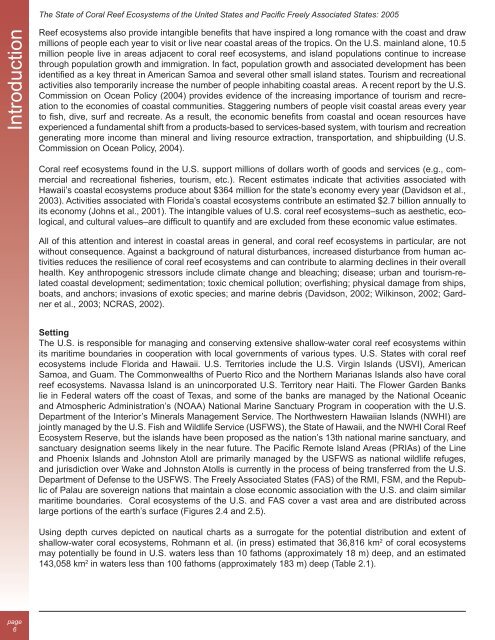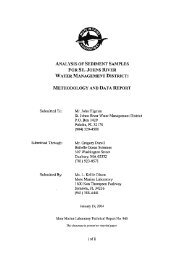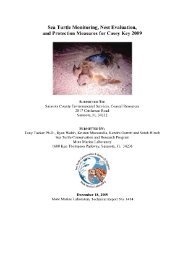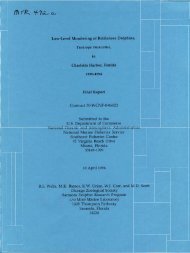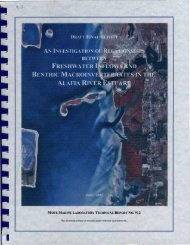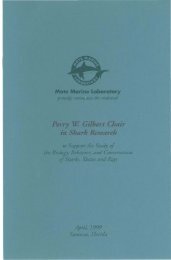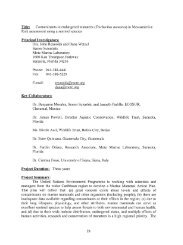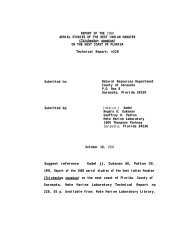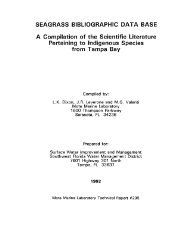- Page 1 and 2: The State of Coral Reef Ecosystems
- Page 3 and 4: The State of Coral Reef Ecosystems
- Page 5 and 6: Chapter 6: The State of Coral Reef
- Page 7 and 8: Chapter 16: The State of Coral Reef
- Page 9 and 10: ment of the condition of the ecosys
- Page 11 and 12: EXECUTIVE SUMMARY The State of Cora
- Page 13 and 14: INTRODUCTION The State of Coral Ree
- Page 15: The State of Coral Reef Ecosystems
- Page 19 and 20: species than degraded areas. The St
- Page 21 and 22: The State of Coral Reef Ecosystems
- Page 23 and 24: The State of Coral Reef Ecosystems
- Page 25 and 26: The State of Coral Reef Ecosystems
- Page 27 and 28: The State of Coral Reef Ecosystems
- Page 29 and 30: The State of Coral Reef Ecosystems
- Page 31 and 32: The State of Coral Reef Ecosystems
- Page 33 and 34: The State of Coral Reef Ecosystems
- Page 35 and 36: The State of Coral Reef Ecosystems
- Page 37 and 38: of an unknown volume primarily supp
- Page 39 and 40: The State of Coral Reef Ecosystems
- Page 41 and 42: The State of Coral Reef Ecosystems
- Page 43 and 44: The State of Coral Reef Ecosystems
- Page 45 and 46: Other Threats Crown-of-Thorns Starf
- Page 47 and 48: REFERENCES The State of Coral Reef
- Page 49 and 50: The State of Coral Reef Ecosystems
- Page 51 and 52: The State of Coral Reef Ecosystems
- Page 53 and 54: The State of Coral Reef Ecosystems
- Page 55 and 56: The State of Coral Reef Ecosystems
- Page 57 and 58: ENVIRONMENTAL AND ANTHROPOGENIC STR
- Page 59 and 60: The State of Coral Reef Ecosystems
- Page 61 and 62: The State of Coral Reef Ecosystems
- Page 63 and 64: The State of Coral Reef Ecosystems
- Page 65 and 66: The State of Coral Reef Ecosystems
- Page 67 and 68:
ECOSYSTEM COMPONENT Water quality 2
- Page 69 and 70:
WATER QUALITY USVI DPNR/DEP Water Q
- Page 71 and 72:
The State of Coral Reef Ecosystems
- Page 73 and 74:
% Cover The State of Coral Reef Eco
- Page 75 and 76:
UVI-CMES Video Assessment of Benthi
- Page 77 and 78:
St. Thomas The percent cover of liv
- Page 79 and 80:
The State of Coral Reef Ecosystems
- Page 81 and 82:
The State of Coral Reef Ecosystems
- Page 83 and 84:
ASSOCIATED BIOLOGICAL COMMUNITIES T
- Page 85 and 86:
Historical data collected by previo
- Page 87 and 88:
The State of Coral Reef Ecosystems
- Page 89 and 90:
The State of Coral Reef Ecosystems
- Page 91 and 92:
The State of Coral Reef Ecosystems
- Page 93 and 94:
Other Management Tools The DFW has
- Page 95 and 96:
REFERENCES The State of Coral Reef
- Page 97 and 98:
The State of Coral Reef Ecosystems
- Page 99 and 100:
The State of Coral Reef Ecosystems
- Page 101 and 102:
The State of Coral Reef Ecosystems
- Page 103 and 104:
The State of Coral Reef Ecosystems
- Page 105 and 106:
The State of Coral Reef Ecosystems
- Page 107 and 108:
The State of Coral Reef Ecosystems
- Page 109 and 110:
The State of Coral Reef Ecosystems
- Page 111 and 112:
According to Sadovy (1992) export o
- Page 113 and 114:
32.3 (± 4.8 SE) and the number of
- Page 115 and 116:
The State of Coral Reef Ecosystems
- Page 117 and 118:
The State of Coral Reef Ecosystems
- Page 119 and 120:
BENTHIC HABITATS U.S. National Cora
- Page 121 and 122:
The State of Coral Reef Ecosystems
- Page 123 and 124:
The State of Coral Reef Ecosystems
- Page 125 and 126:
The State of Coral Reef Ecosystems
- Page 127 and 128:
The State of Coral Reef Ecosystems
- Page 129 and 130:
The State of Coral Reef Ecosystems
- Page 131 and 132:
The State of Coral Reef Ecosystems
- Page 133 and 134:
Results and Discussion By relating
- Page 135 and 136:
Coral reefs exhibited the highest n
- Page 137 and 138:
The State of Coral Reef Ecosystems
- Page 139 and 140:
REFERENCES The State of Coral Reef
- Page 141 and 142:
The State of Coral Reef Ecosystems
- Page 143 and 144:
The State of Coral Reef Ecosystems
- Page 145 and 146:
The State of Coral Reef Ecosystems
- Page 147 and 148:
Tropical Storms Navassa’s oceanic
- Page 149 and 150:
Marine Debris There is a small amou
- Page 151 and 152:
The State of Coral Reef Ecosystems
- Page 153 and 154:
The State of Coral Reef Ecosystems
- Page 155 and 156:
The State of Coral Reef Ecosystems
- Page 157 and 158:
The State of Coral Reef Ecosystems
- Page 159 and 160:
REFERENCES The State of Coral Reef
- Page 161 and 162:
Figure 7.1. Locator map for Florida
- Page 163 and 164:
The State of Coral Reef Ecosystems
- Page 165 and 166:
The State of Coral Reef Ecosystems
- Page 167 and 168:
and supported 4,500 jobs. Reefs off
- Page 169 and 170:
The State of Coral Reef Ecosystems
- Page 171 and 172:
The State of Coral Reef Ecosystems
- Page 173 and 174:
een well documented (http://www.pbs
- Page 175 and 176:
The State of Coral Reef Ecosystems
- Page 177 and 178:
The State of Coral Reef Ecosystems
- Page 179 and 180:
geographical determinants of water
- Page 181 and 182:
tinel species; they bleach at a sli
- Page 183 and 184:
The State of Coral Reef Ecosystems
- Page 185 and 186:
The State of Coral Reef Ecosystems
- Page 187 and 188:
tissue loss. The tagged population
- Page 189 and 190:
In a report to the U.S. Congress (U
- Page 191 and 192:
The State of Coral Reef Ecosystems
- Page 193 and 194:
Ferro et al. (2003) used the RVC me
- Page 195 and 196:
The State of Coral Reef Ecosystems
- Page 197 and 198:
The State of Coral Reef Ecosystems
- Page 199 and 200:
Researchers at NCRI are also curren
- Page 201 and 202:
The databases of reef fish in Browa
- Page 203 and 204:
The State of Coral Reef Ecosystems
- Page 205 and 206:
The State of Coral Reef Ecosystems
- Page 207 and 208:
The State of Coral Reef Ecosystems
- Page 209 and 210:
The State of Coral Reef Ecosystems
- Page 211 and 212:
The State of Coral Reef Ecosystems
- Page 213 and 214:
The State of Coral Reef Ecosystems
- Page 215 and 216:
The State of Coral Reef Ecosystems
- Page 217 and 218:
The State of Coral Reef Ecosystems
- Page 219 and 220:
The State of Coral Reef Ecosystems
- Page 221 and 222:
WATER QUALITY The State of Coral Re
- Page 223 and 224:
The State of Coral Reef Ecosystems
- Page 225 and 226:
The State of Coral Reef Ecosystems
- Page 227 and 228:
The State of Coral Reef Ecosystems
- Page 229 and 230:
The State of Coral Reef Ecosystems
- Page 231 and 232:
The State of Coral Reef Ecosystems
- Page 233 and 234:
Figure 9.1. Maps of the MHI showing
- Page 235 and 236:
The State of Coral Reef Ecosystems
- Page 237 and 238:
tion (Friedlander and Parrish, 1998
- Page 239 and 240:
Seven major wastewater treatment pl
- Page 241 and 242:
The State of Coral Reef Ecosystems
- Page 243 and 244:
Figure 9.12. Commercial catch data
- Page 245 and 246:
The State of Coral Reef Ecosystems
- Page 247 and 248:
The State of Coral Reef Ecosystems
- Page 249 and 250:
The State of Coral Reef Ecosystems
- Page 251 and 252:
The State of Coral Reef Ecosystems
- Page 253 and 254:
Table 9.5. Extant monitoring progra
- Page 255 and 256:
WATER QUALITY The State of Coral Re
- Page 257 and 258:
BENTHIC HABITATS The State of Coral
- Page 259 and 260:
The State of Coral Reef Ecosystems
- Page 261 and 262:
The State of Coral Reef Ecosystems
- Page 263 and 264:
The State of Coral Reef Ecosystems
- Page 265 and 266:
The State of Coral Reef Ecosystems
- Page 267 and 268:
The State of Coral Reef Ecosystems
- Page 269 and 270:
The State of Coral Reef Ecosystems
- Page 271 and 272:
MLCD HECTARES YEAR ESTAB. OAHU The
- Page 273 and 274:
REFERENCES The State of Coral Reef
- Page 275 and 276:
The State of Coral Reef Ecosystems
- Page 277 and 278:
The State of Coral Reef Ecosystems
- Page 279 and 280:
The State of Coral Reef Ecosystems
- Page 281 and 282:
The State of Coral Reef Ecosystems
- Page 283 and 284:
In late summer 2004, a second episo
- Page 285 and 286:
The State of Coral Reef Ecosystems
- Page 287 and 288:
The State of Coral Reef Ecosystems
- Page 289 and 290:
The State of Coral Reef Ecosystems
- Page 291 and 292:
The State of Coral Reef Ecosystems
- Page 293 and 294:
Figure 10.13. Monitoring locations
- Page 295 and 296:
waiian Archipelago have been measur
- Page 297 and 298:
The coral reefs of the NWHI are exp
- Page 299 and 300:
The State of Coral Reef Ecosystems
- Page 301 and 302:
methods allows more precise detecti
- Page 303 and 304:
The State of Coral Reef Ecosystems
- Page 305 and 306:
The State of Coral Reef Ecosystems
- Page 307 and 308:
ASSOCIATED BIOLOGICAL COMMUNITIES T
- Page 309 and 310:
Figure 10.29. Time series of the es
- Page 311 and 312:
Figure 10.33. Body size (TL) freque
- Page 313 and 314:
The State of Coral Reef Ecosystems
- Page 315 and 316:
The State of Coral Reef Ecosystems
- Page 317 and 318:
The State of Coral Reef Ecosystems
- Page 319 and 320:
The State of Coral Reef Ecosystems
- Page 321 and 322:
The State of Coral Reef Ecosystems
- Page 323 and 324:
Figure 11.1. Map of the locations i
- Page 325 and 326:
Tropical Storms Tropical storms and
- Page 327 and 328:
The State of Coral Reef Ecosystems
- Page 329 and 330:
Figure 11.8. Monitoring program sit
- Page 331 and 332:
WATER QUALITY The State of Coral Re
- Page 333 and 334:
BENTHIC HABITATS The State of Coral
- Page 335 and 336:
The State of Coral Reef Ecosystems
- Page 337 and 338:
The State of Coral Reef Ecosystems
- Page 339 and 340:
Results and Discussion Territory-wi
- Page 341 and 342:
The second artisanal fishery target
- Page 343 and 344:
Marine Protected Areas Program Mari
- Page 345 and 346:
The State of Coral Reef Ecosystems
- Page 347 and 348:
The State of Coral Reef Ecosystems
- Page 349 and 350:
Figure 12.1. Locator map for the Pa
- Page 351 and 352:
The State of Coral Reef Ecosystems
- Page 353 and 354:
The State of Coral Reef Ecosystems
- Page 355 and 356:
The State of Coral Reef Ecosystems
- Page 357 and 358:
The State of Coral Reef Ecosystems
- Page 359 and 360:
Figure 12.8. Monitoring locations i
- Page 361 and 362:
• Poor water circulation within P
- Page 363 and 364:
a subsurface ocean data platform at
- Page 365 and 366:
Shift in coral community structure
- Page 367 and 368:
ALGAE The State of Coral Reef Ecosy
- Page 369 and 370:
ASSOCIATED BIOLOGICAL COMMUNITIES T
- Page 371 and 372:
The State of Coral Reef Ecosystems
- Page 373 and 374:
trevally [C. melampygus]). A half d
- Page 375 and 376:
The State of Coral Reef Ecosystems
- Page 377 and 378:
The State of Coral Reef Ecosystems
- Page 379 and 380:
The State of Coral Reef Ecosystems
- Page 381 and 382:
REFERENCES The State of Coral Reef
- Page 383 and 384:
The State of Coral Reef Ecosystems
- Page 385 and 386:
ENVIRONMENTAL AND ANTHROPOGENIC STR
- Page 387 and 388:
The State of Coral Reef Ecosystems
- Page 389 and 390:
The State of Coral Reef Ecosystems
- Page 391 and 392:
crusting, foliose, and Millepora sp
- Page 393 and 394:
The State of Coral Reef Ecosystems
- Page 395 and 396:
REFERENCES The State of Coral Reef
- Page 397 and 398:
The State of Coral Reef Ecosystems
- Page 399 and 400:
ENVIRONMENTAL AND ANTHROPOGENIC STR
- Page 401 and 402:
Fishing Commercial fishing in the F
- Page 403 and 404:
The State of Coral Reef Ecosystems
- Page 405 and 406:
The State of Coral Reef Ecosystems
- Page 407 and 408:
The State of Coral Reef Ecosystems
- Page 409 and 410:
The State of Coral Reef Ecosystems
- Page 411 and 412:
offshore banks (18 km x 22 km) in w
- Page 413 and 414:
The State of Coral Reef Ecosystems
- Page 415 and 416:
The State of Coral Reef Ecosystems
- Page 417 and 418:
Tropical Storms Typhoons are a rout
- Page 419 and 420:
about 143,400 lbs, (65,000 kg) alth
- Page 421 and 422:
The State of Coral Reef Ecosystems
- Page 423 and 424:
The State of Coral Reef Ecosystems
- Page 425 and 426:
The State of Coral Reef Ecosystems
- Page 427 and 428:
Figure 15.16. Monitoring site locat
- Page 429 and 430:
DEQ Beach Water Quality Monitoring
- Page 431 and 432:
The State of Coral Reef Ecosystems
- Page 433 and 434:
BENTHIC HABITATS The State of Coral
- Page 435 and 436:
The State of Coral Reef Ecosystems
- Page 437 and 438:
The State of Coral Reef Ecosystems
- Page 439 and 440:
The State of Coral Reef Ecosystems
- Page 441 and 442:
The State of Coral Reef Ecosystems
- Page 443 and 444:
The State of Coral Reef Ecosystems
- Page 445 and 446:
The State of Coral Reef Ecosystems
- Page 447 and 448:
The State of Coral Reef Ecosystems
- Page 449 and 450:
REFERENCES The State of Coral Reef
- Page 451 and 452:
The State of Coral Reef Ecosystems
- Page 453 and 454:
Figure 16.1. Locator map for Guam.
- Page 455 and 456:
ENVIRONMENTAL AND ANTHROPOGENIC STR
- Page 457 and 458:
The State of Coral Reef Ecosystems
- Page 459 and 460:
The State of Coral Reef Ecosystems
- Page 461 and 462:
The State of Coral Reef Ecosystems
- Page 463 and 464:
The State of Coral Reef Ecosystems
- Page 465 and 466:
The State of Coral Reef Ecosystems
- Page 467 and 468:
The State of Coral Reef Ecosystems
- Page 469 and 470:
The State of Coral Reef Ecosystems
- Page 471 and 472:
WATER QUALITY The State of Coral Re
- Page 473 and 474:
Methods For the quantitative survey
- Page 475 and 476:
Results and Discussion During these
- Page 477 and 478:
The State of Coral Reef Ecosystems
- Page 479 and 480:
138% within the Piti Bomb Holes Mar
- Page 481 and 482:
The State of Coral Reef Ecosystems
- Page 483 and 484:
The State of Coral Reef Ecosystems
- Page 485 and 486:
The State of Coral Reef Ecosystems
- Page 487 and 488:
Local Action Strategies in Guam *)
- Page 489 and 490:
The State of Coral Reef Ecosystems
- Page 491 and 492:
The State of Coral Reef Ecosystems
- Page 493 and 494:
REFERENCES The State of Coral Reef
- Page 495 and 496:
The State of Coral Reef Ecosystems
- Page 497 and 498:
The State of Coral Reef Ecosystems
- Page 499 and 500:
The State of Coral Reef Ecosystems
- Page 501 and 502:
The State of Coral Reef Ecosystems
- Page 503 and 504:
Figure 17.5. Seagrass (left) and co
- Page 505 and 506:
The State of Coral Reef Ecosystems
- Page 507 and 508:
WATER QUALITY The State of Coral Re
- Page 509 and 510:
The State of Coral Reef Ecosystems
- Page 511 and 512:
ASSOCIATED BIOLOGICAL COMMUNITIES T
- Page 513 and 514:
CURRENT CONSERVATION MANAGEMENT ACT
- Page 515 and 516:
The State of Coral Reef Ecosystems
- Page 517 and 518:
The State of Coral Reef Ecosystems
- Page 519 and 520:
The State of Coral Reef Ecosystems
- Page 521 and 522:
USVI Puerto Rico Navassa Florida Fl
- Page 523 and 524:
The State of Coral Reef Ecosystems
- Page 525 and 526:
The State of Coral Reef Ecosystems
- Page 527 and 528:
The State of Coral Reef Ecosystems
- Page 529 and 530:
ird stakes. The generally accepted
- Page 531 and 532:
REFERENCES The State of Coral Reef
- Page 533:
United States Department of Commerc


